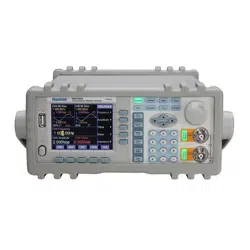Loading ...
Loading ...
Loading ...

operation is not valid for frequency modulation deviation or amplitude modulation depth. In this mode, if “FM
Deviation” or “AM Depth” is selected by the corresponding soft key, the instrument turns to internal modulation.
“Modulation In” connector on the rear panel should be disconnected, otherwise there will be significant effect on
the internal modulation.
3.8 Burst Output
Press key [BURST] to select “CHB Burst” option. “CHB Burst” is displayed in the upper-left portion of the TFT.
The function generator outputs a waveform with a specified number of cycles at the burst frequency continuously
at the CHB Output. Each set has a preset burst count and there is a time interval between each burst.
3.8.1 Set the Frequency of Channel B
Since channel B signal is the burst source for burst output, frequency and amplitude of channel B signal should
firstly be set up. The settings of the frequency and amplitude are introduced in the section 3.3.
3.8.2 Set Burst Count
Select “Cycles” option by the corresponding soft key. The burst count changes to yellow. Input a new burst count
number here by numeric keypad or rotary dial. Press the key corresponding to [CYCL] to confirm the new data
input. If the burst frequency is fixed, the maximum value of the burst count is limited. The lower burst frequency
is, or we say the longer burst period is, the bigger the burst count number can be set. Vise visa, the smaller burst
count number is. If the burst frequency is not set, the burst count can be set firstly and then the burst frequency
value is adjusted in order to keep an appropriate time interval between each burst.
3.8.3 Set the Burst Frequency
Select “Burst Freq” option by the corresponding soft key. The burst frequency changes to yellow. Input a new
burst frequency data here by numeric keypad or rotary dial. Press the soft key corresponding to the frequency
units to confirm the new data input. The burst frequency is determined by the Channel B frequency value and the
burst count number. The multiply of channel B signal period value and burst count number is the time needed for
a set of burst. In order to keep an appropriate time interval between each burst, the burst period should be greater
than the time of a burst. Otherwise all bursts are connected to each other and the waveform is not the burst signal
anymore.
3.8.4 Burst Start Phase
The start phase of each set of burst waveforms is fixed to 0 degree.
3.8.5 Set the Single Burst Mode
Select “Single” option by the corresponding soft key. The function generator turns off the continuous burst mode
and signal output is 0. In the single burst mode, press key [CHB Output] once, the burst process executes once
and the function generator outputs one burst waveform according to the preset value of the burst count. If the burst
count number is set to 1, the single burst can be operated manually. If the “Int Burst” option is selected, the burst
process is back to the continuous burst mode. If the “TTL Burst” option is selected, use “Count In” connector to
import the burst signal. In this case, a frequency counter input function should be equipped with the instrument.
Burst count can be used to test the dynamic characteristics of the audio equipment and calibrate the counter.
- 20 -
Loading ...
Loading ...
Loading ...
